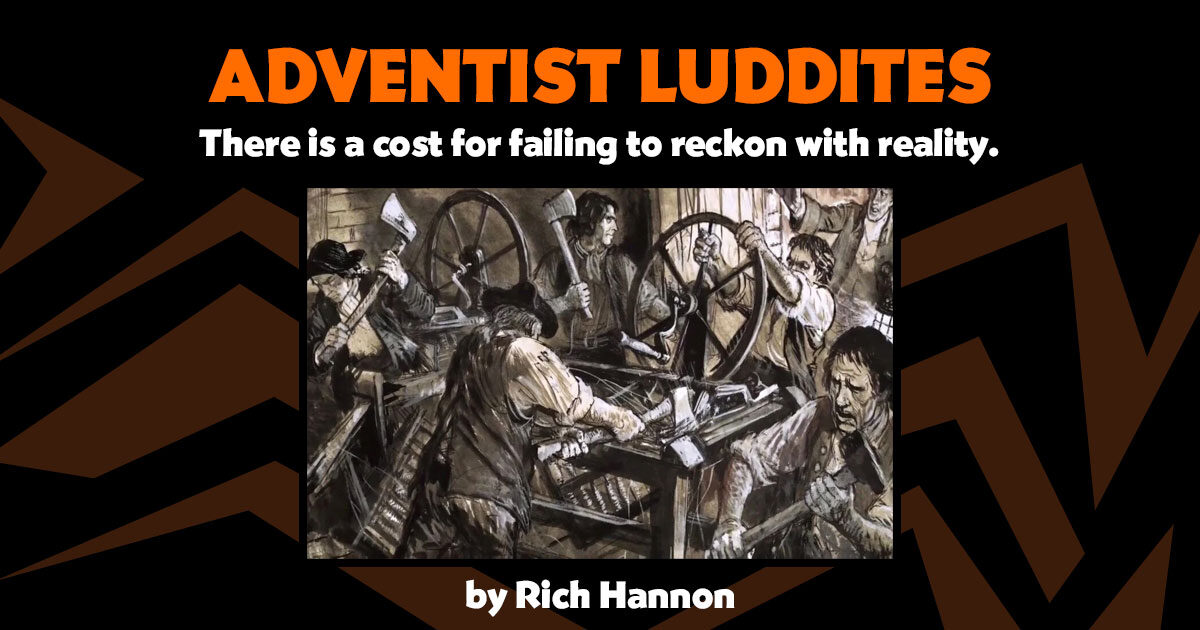Adventist Luddites
by Rich Hannon | 4 March 2025 |
I suspect the word Luddite has quietly slipped away from usage and recognition. It has two meanings: a narrow historical meaning in the Industrial Revolution, and a broader one describing someone who is actively opposed to new technology or new ways of working.
However, I wish to define it in a somewhat altered analogic form, as applied to the Adventist subculture.
Hands to machines
Britain in the 19th century gave birth to a sweeping collection of changes we now call the Industrial Revolution. It began with textiles: a transformation in how cloth was made. Cloth is, of course, made by weaving—but the transformation was from human weavers to using machines to weave. Steam power, which had developed slowly through the 18th century, found multiple uses in the early 19th, and dominated until oil-based fuels and electricity replaced it.
But shifting from human to machine power caused enormous disruption in how work was done. Many skilled craftsmen became redundant almost overnight. There was no social safety net. Job losses produced unprecedented societal upheaval.
Not everyone took this shift from stability to poverty lying down. There were riots, with the unemployed driven by fear to attack factories and destroy machinery. They wanted life to return to what it was: to a time when they knew how to make a living, had stability, and even some status. (The “Ludd” part of Luddite referenced a probably apocryphal 18th-century figure named Ned Ludd, who was supposed to have smashed a powered mechanical loom that was replacing his job.)
Creative destruction
The term for this in economics is creative destruction. New and better technology replaces the old. When the automobile eclipsed horse-drawn transportation many industries collapsed as a result: the horse market, wagon construction, even buggy whips and nails for horseshoes. Companies failed. Unemployment followed.
But new entrepreneurial ventures created other employment opportunities to replace the destruction. Still, many people who worked in the failing industries would not become those who secured new jobs. Nowadays coal production has waned, with solar and wind power replacing them—but Appalachia hasn’t flipped over its workforce to new employment. The coal belt and rust belt have been left a legacy of poverty and drug addiction.
But the problem here, seen throughout history and rapidly accelerating in modernity, is that change happens and is unstoppable. Usually it is for the better. But that’s no comfort to those who cannot transition.
The Luddite label has been widely used to apply to those who try to push back against the inevitability of change.
So where do we come into this picture?
Adventist Luddites
For an Adventist context, let Luddite stand for the negative reaction people have toward perceived pressure for change in their religious experience. This would then be coupled with a desire and drive to halt any alterations that they consider disruptive.
There are evident differences between using the term Luddite in its typical sense, and how I’m using it. Technology progress really is inevitable—and so is creative destruction. That’s not necessarily true in the religious realm. Here one needs to fairly consider the clear biblical mandate to support the “faith which was once for all delivered to the saints” (Jude 1:3). There is no inevitability for doctrinal change and practice, so there is a legitimate push-pull dialog whenever change possibilities are on the table. A classic example is the Council of Nicaea, when Arianism was considered and rejected.
Further, I’m in no way trying to tar conservatives with a broad brush. While most Adventists are conservative, not all reject change. And skepticism is also quite legitimate.
But it gets Luddite when there is no openness to change—when there is reaction to perceived threat and a desire to push back, regardless of the quality of the case in favor of revising beliefs. The analog to smashing the powered loom comes when fear that what you’ve invested in might be wrong, and you become purely reactionary. Resistance comes in forms such as:
- war rhetoric and disparagement of those proposing change;
- exhortations to reject anything other than current orthodoxy;
- problematic argumentation that the change-averse person proposes, yet won’t consider any critique of it.
Such actions can comfort the resistor, even as they seem to sustain the status quo and preserve the high moral ground.
Demonizing can be seen in right-wing, lay-run websites. But it is also active at the General Conference, exemplified in sermons from our church president. Unscrutinized arguments happen everywhere, ranging from Adventist Review op-eds, to the recent “Faith and Science” conferences, where a very skewed set of presentations try to support Young Earth Creationism without ever really recognizing the full case against that desired view.
A related analogy
In the same time frame, when Britain was painfully transitioning to industry with its accompanying job losses, the government chose a very consequential economic policy. There was then a British empire, comprised of countries such as India, Australia, Canada, and African colonies. Britain put a tariff wall around the empire, making it unprofitable for outside countries to sell into it—essentially a closed market.
But many other countries, notably the United States and Germany, were rapidly advancing and, by the turn into the 20th century, had surpassed Britain technologically. Industrialists such as Carnegie and Rockefeller—however exploitive their business methods were—constantly innovated with new processes and machinery.
Britain mostly did not. The tariff wall was a disincentive for British industrialists to continue upgrading their factories, and they ultimately became noncompetitive. So by the First World War the gap was too great, and Britain permanently lost its industrial primacy.
The Adventist tariff wall
Now all analogies are partial, but here’s where there is, I believe, a hard reckoning for the church in the future. Adventism has never been proactive in addressing issues confronting it. From the Ellen White disclosures, through Glacier View, now into a full-on resistance to an objective look at both science and hermeneutics, there has been a collective effort by leaders to place an ideological “tariff wall” around the church. Perhaps unintended, but nonetheless real.
Analogous to the British economic experience, there is a cost for this insulation. It’s already visible with the graying of membership in the economic first world. Our youth are leaving. You can only “hold fast” without addressing problems for so long. Then you have to reckon with the explosion of information and questions being asked but not answered.
In writing this, I have been conflicted in choosing a pejorative label for the subset of Adventist conservatives I’m defining. I don’t care whether the word “Luddite” survives, in an Adventist context, beyond this article. I’ve appropriated it because I think the analogy holds sufficiently to help recognize characteristics found within our church that, while sincerely held, are harmful.
We have already paid a price for failing to deal with legitimate questions that threaten our orthodoxy, and I think the cost will escalate over time. Just exhorting the membership to “do this, not that” is an abrogation of leadership.
It must change before Adventism shrinks into irrelevance.
 Rich Hannon is a retired software engineer. His avocations include philosophy, geology, and medieval history.
Rich Hannon is a retired software engineer. His avocations include philosophy, geology, and medieval history.
To comment, click/tap here.




